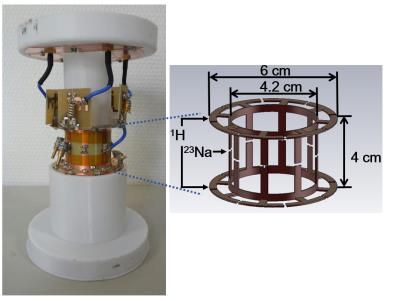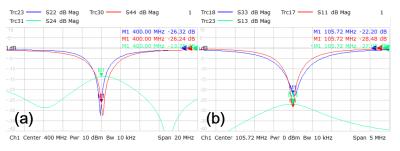4322
Folded four-ring double-tuned birdcage coil design1Institute of Neuroscience and Medicine - 4, Forschungszentrum Juelich, Juelich, Germany, 2Faculty of Medicine, Department of Neurology, JARA, RWTH Aachen University, Aachen, Germany
Synopsis
In this work, we designed a double-tuned 1H/23Na four-ring birdcage coil with a modification that entailed folding the outer end-rings by 90 degrees to overcome the available space limitation. And 23Na SNR of the folded four-ring birdcage coil reached more than 93% of that obtained with the single-tuned birdcage coil. One benefit of folded four-ring birdcage coil compared to conventional four-ring birdcage coil is that there is no space restriction. This helps to build double-tuned coils that have a smaller diameter, leading to higher filling factors.
Purpose / Introduction
Conventionally, a double-tuned birdcage coil can be designed in various ways, such as alternate rungs, four-ring, traps and/or PIN diodes1-4. Among them, the four-ring approach has an advantage in terms of efficiency and homogeneity for both frequencies when it meets its optimised inner and outer end-ring length ratio5. The four-ring method employs tuning at one resonance frequency using the two inner end-rings and at the other frequency using the two outer end-rings. The inner structure tends to be tuned at the X-nuclei with a low-pass configuration since this provides minimum loss on the X-nucleus channel6. However, the requirement of an additional length for the end-rings restricts the accessible space, in particular for brain studies. In this work, we designed a double-tuned 1H / 23Na four-ring birdcage coil with a modification that entailed folding the outer end-rings by 90 degrees to overcome the available space limitation, and we compared the performance of this design with a single-tuned, birdcage coil with the same geometry.Methods
The folded four-ring quadrature birdcage coil was designed and constructed with an outer high-pass coil for 1H (400 MHz) and inner low-pass coil for 23Na (105.72 MHz at 9.4T) as shown in Fig. 1. The performance of the coil was evaluated on the bench and all the experiments were conducted on a home-built 9.4T animal scanner. A cylindrical saline phantom (100 mm length and 28 mm diameter) containing 75 mM NaCl was prepared. Using the 1H configuration, the static magnetic field was adjusted and localiser images were obtained. 23Na images were acquired using a 3D FLASH sequence (TR = 30 ms, TE = 2.28 ms, 5 mm x 5 mm x 5 mm resolution and scan time = 1:56 minutes). The signal-to-noise ratio (SNR) was measured and compared with a single-tuned coil with same geometry and under the same conditions.Result
S-parameters (S11, S22 and S21) for both 23Na and 1H were measured using a network analyser (ZNB, Rohde & Schwarz) as depicted in Fig. 2. Return losses were less than -22 dB at all ports, and the isolation between the two ports at 1H and 23Na were -13.76 dB and -27.05 dB, respectively. Figure 3. shows 1H localiser image obtained using outer 1H coil and 23Na magnitude images; the SNR values of the single-tuned (74.9) and double-tuned (69.7) are also included.Disdussion / Conclusion
The length of the folded four-ring birdcage coil is as same as the single-tuned birdcage coil. 23Na SNR of the folded four-ring birdcage coil reached more than 93% of that obtained with the single-tuned birdcage coil. One benefit of folded four-ring birdcage coil compared to conventional four-ring birdcage coil is that there is no space restriction. This helps to build double-tuned coils that have a smaller diameter, leading to higher filling factors. Otherwise, for brain imaging, for example, one would need a larger coil which would lead to a degraded SNR.Acknowledgements
No acknowledgement found.References
[1] Amari, S., Müfit Ulug, A., Bornemann, J., Van Zijl, P., & Barker, P. B. (1997). Multiple tuning of birdcage resonators. Magnetic resonance in medicine, 37(2), 243-251.
[2] Murphyboesch, J., Srinivasan, R., Carvajal, L., & Brown, T. R. (1994). Two configurations of the four-ring birdcage coil for 1 H imaging and 1 H-decoupled 31 P spectroscopy of the human head. Journal of Magnetic Resonance, Series B, 103(2), 103-114.
[3] Schnall, M. D., Subramanian, V. H., Leigh, J. S., & Chance, B. (1985). A new double-tuned probed for concurrent 1 H and 31 P NMR. Journal of Magnetic Resonance (1969), 65(1), 122-129.
[4] LIM, H., et al. Construction and evaluation of a switch-tuned 13C-1H birdcage radiofrequency coil for imaging the metabolism of hyperpolarized 13C-enriched compounds. Journal of Magnetic Resonance Imaging, 2014, 40.5: 1082-1090.
[5] DUAN, Y., et al. Computational and experimental optimization of a double-tuned 1H/31P four-ring birdcage head coil for MRS at 3T. Journal of Magnetic Resonance Imaging, 2009, 29.1: 13-22.
[6] Murphy-Boesch, J. (2012). Double-Tuned Birdcage Coils: Construction and Tuning. eMagRes.
Figures


